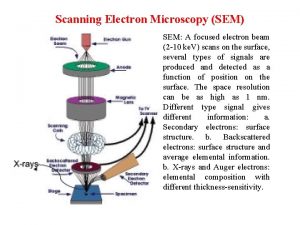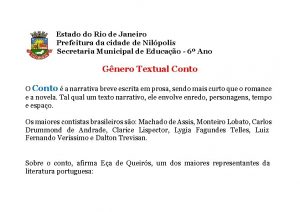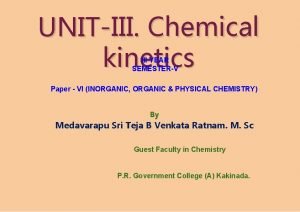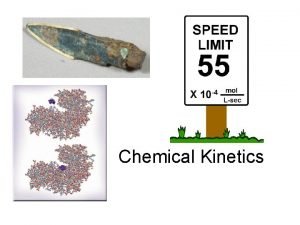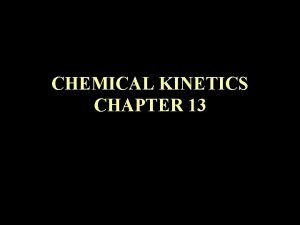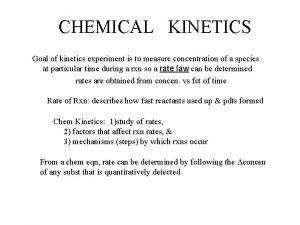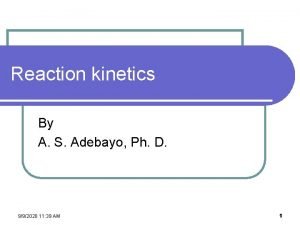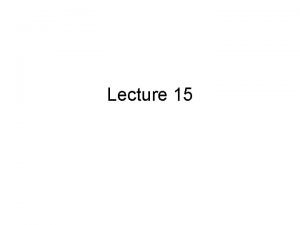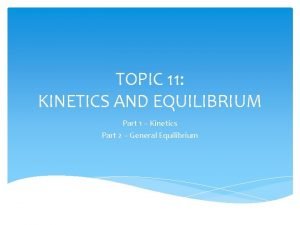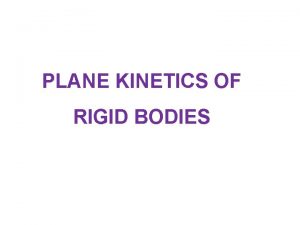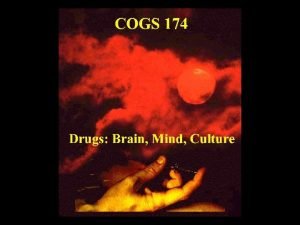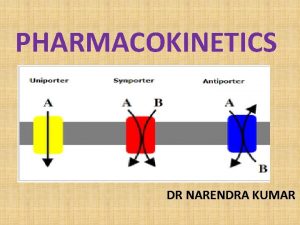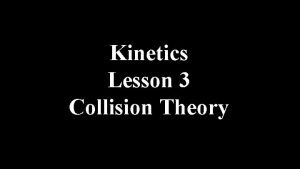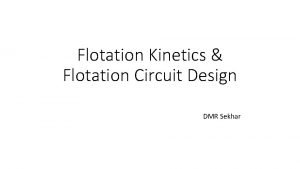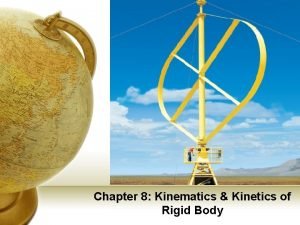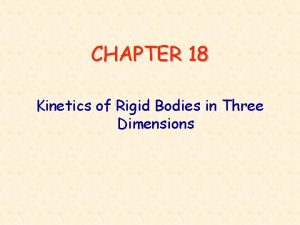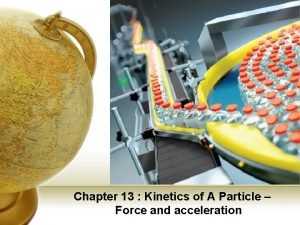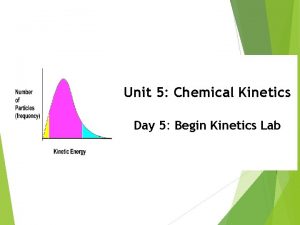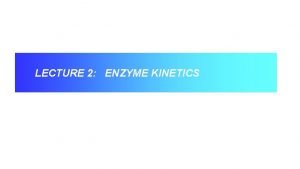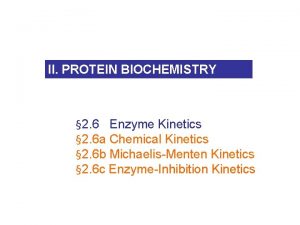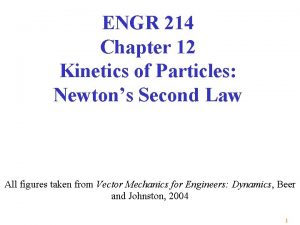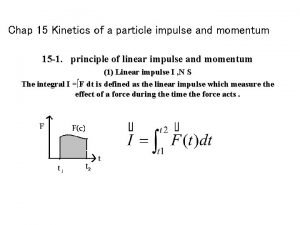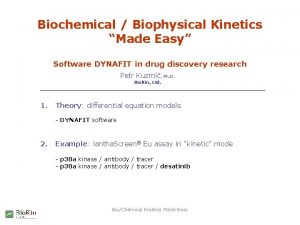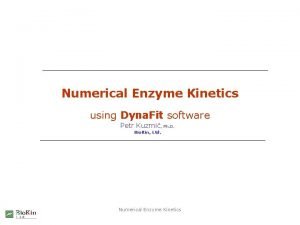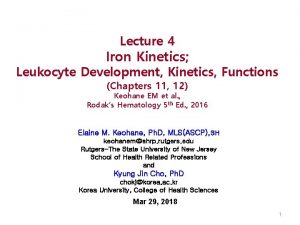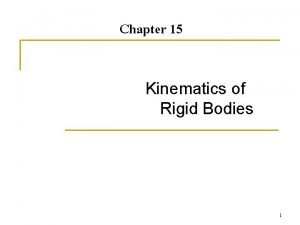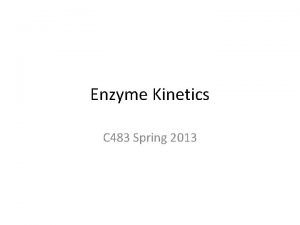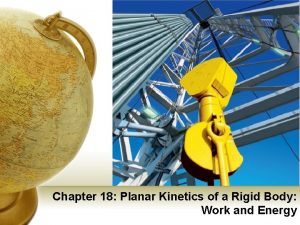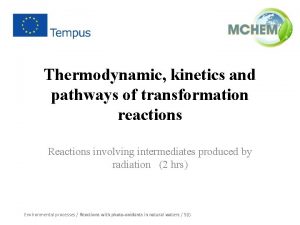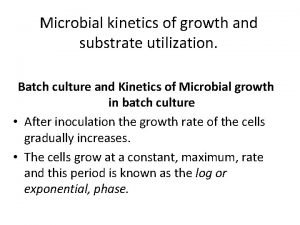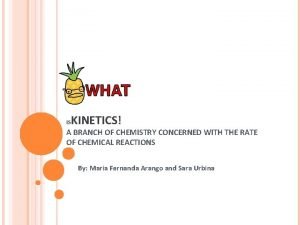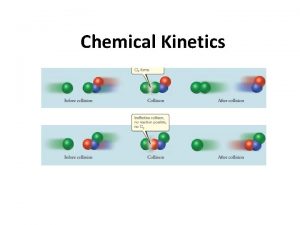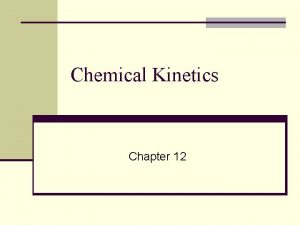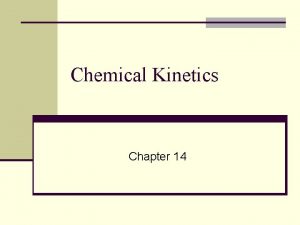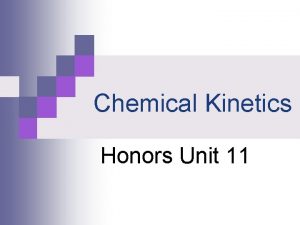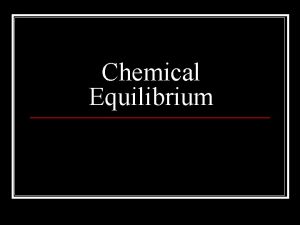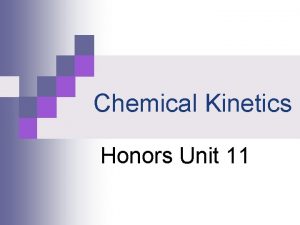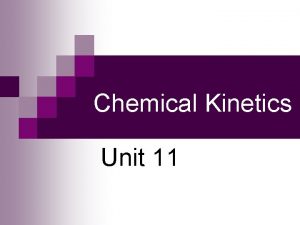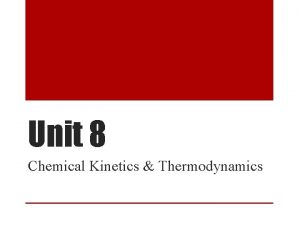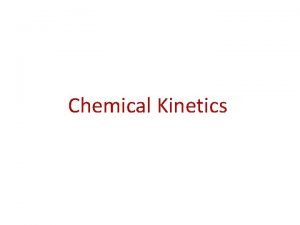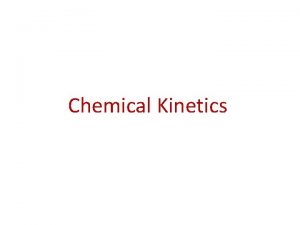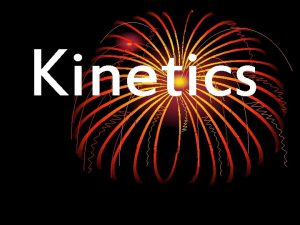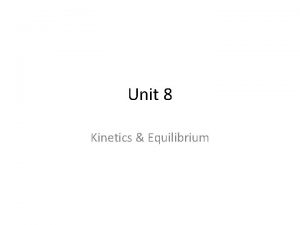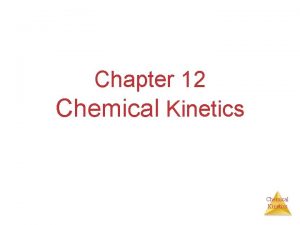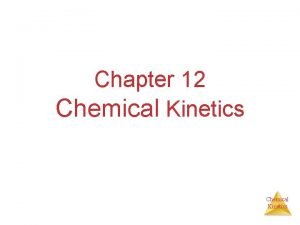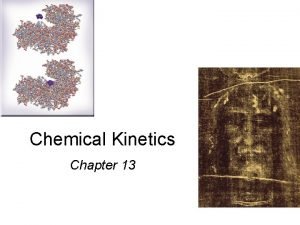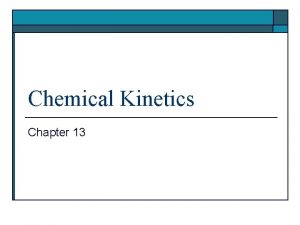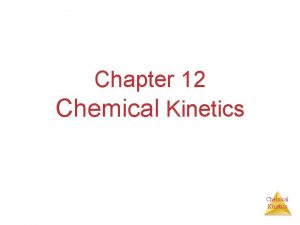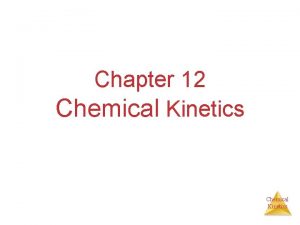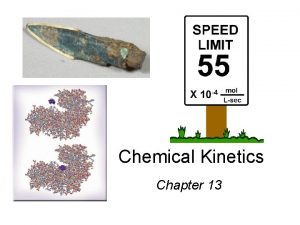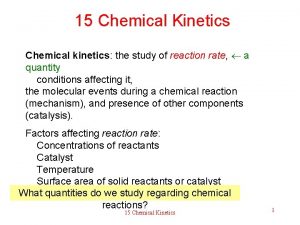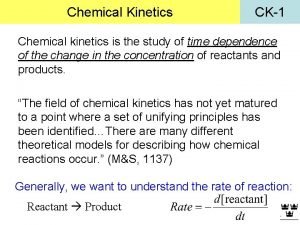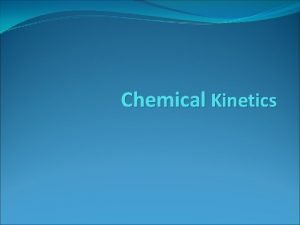Chemical Kinetics Chapter 13 Sem 12017 1 Copyright


![A B D[A] rate = Dt D[B] rate = Dt 3 A B D[A] rate = Dt D[B] rate = Dt 3](https://slidetodoc.com/presentation_image_h/252864e45c1e2d54cb8b4b27579a6845/image-3.jpg)













![Example 13. 3 Experiments 2 and 3 indicate that doubling [H 2] at constant Example 13. 3 Experiments 2 and 3 indicate that doubling [H 2] at constant](https://slidetodoc.com/presentation_image_h/252864e45c1e2d54cb8b4b27579a6845/image-17.jpg)













![First-order reaction A product # of half-lives [A] = [A]0/n 1 2 2 4 First-order reaction A product # of half-lives [A] = [A]0/n 1 2 2 4](https://slidetodoc.com/presentation_image_h/252864e45c1e2d54cb8b4b27579a6845/image-31.jpg)


![Second-Order Reactions A product D[A] rate = Dt rate M/s = = 1/M • Second-Order Reactions A product D[A] rate = Dt rate M/s = = 1/M •](https://slidetodoc.com/presentation_image_h/252864e45c1e2d54cb8b4b27579a6845/image-34.jpg)


![Example 13. 7 where [A]t is the concentration at t = 2. 0 min. Example 13. 7 where [A]t is the concentration at t = 2. 0 min.](https://slidetodoc.com/presentation_image_h/252864e45c1e2d54cb8b4b27579a6845/image-37.jpg)
![Example 13. 7 For [I]0 = 0. 42 M Check These results confirm that Example 13. 7 For [I]0 = 0. 42 M Check These results confirm that](https://slidetodoc.com/presentation_image_h/252864e45c1e2d54cb8b4b27579a6845/image-38.jpg)
![Zero-Order Reactions A product D[A] rate = Dt D[A] = k Dt rate = Zero-Order Reactions A product D[A] rate = Dt D[A] = k Dt rate =](https://slidetodoc.com/presentation_image_h/252864e45c1e2d54cb8b4b27579a6845/image-39.jpg)






- Slides: 45

Chemical Kinetics Chapter 13 Sem 1/2017 1 Copyright © The Mc. Graw-Hill Companies, Inc. Permission required for reproduction or display.

Chemical Kinetics 13. 1 The Rate of a Reaction Thermodynamics – does a reaction take place? Kinetics – how fast does a reaction proceed? Reaction rate is the change in the concentration of a reactant or a product with time (M/s). A B D[A] rate = Dt D[A] = change in concentration of A over time period Dt D[B] rate = Dt D[B] = change in concentration of B over time period Dt Because [A] decreases with time, D[A] is negative. 2
![A B DA rate Dt DB rate Dt 3 A B D[A] rate = Dt D[B] rate = Dt 3](https://slidetodoc.com/presentation_image_h/252864e45c1e2d54cb8b4b27579a6845/image-3.jpg)
A B D[A] rate = Dt D[B] rate = Dt 3

Reaction Rates and Stoichiometry 2 A B Two moles of A disappear for each mole of B that is formed. 1 D[A] rate = 2 Dt D[B] rate = Dt a. A + b. B c. C + d. D 1 D[A] 1 D[C] 1 D[D] 1 D[B] rate = = a Dt b Dt c Dt d Dt 4

Example 13. 1 Write the rate expressions for the following reactions in terms of the disappearance of the reactants and the appearance of the products:

Example 13. 1 Strategy To express the rate of the reaction in terms of the change in concentration of a reactant or product with time, we need to use the proper sign (minus or plus) and the reciprocal of the stoichiometric coefficient. Solution (a) Because each of the stoichiometric coefficients equals 1, (b) Here the coefficients are 4, 5, 4, and 6, so

Example 13. 2 Consider the reaction Suppose that, at a particular moment during the reaction, molecular oxygen is reacting at the rate of 0. 024 M/s. (a) At what rate is N 2 O 5 being formed? (b) At what rate is NO 2 reacting?

Example 13. 2 Strategy To calculate the rate of formation of N 2 O 5 and disappearance of NO 2, we need to express the rate of the reaction in terms of the stoichiometric coefficients as in Example 13. 1: We are given where the minus sign shows that the concentration of O 2 is decreasing with time.

Example 13. 2 Solution (a) From the preceding rate expression we have Therefore

Example 13. 2 (b) Here we have so

13. 2 The Rate Law The rate law expresses the relationship of the rate of a reaction to the rate constant and the concentrations of the reactants raised to some powers. a. A + b. B c. C + d. D Rate = k [A]x[B]y Reaction is xth order in A Reaction is yth order in B Reaction is (x +y)th order overall 11

F 2 (g) + 2 Cl. O 2 (g) 2 FCl. O 2 (g) rate = k [F 2]x[Cl. O 2]y Double [F 2] with [Cl. O 2] constant Rate doubles x = 1 Quadruple [Cl. O 2] with [F 2] constant rate = k [F 2][Cl. O 2] Rate quadruples y = 1 12

Rate Laws • Rate laws are always determined experimentally. • Reaction order is always defined in terms of reactant (not product) concentrations. • The order of a reactant is not related to the stoichiometric coefficient of the reactant in the balanced chemical equation. F 2 (g) + 2 Cl. O 2 (g) 2 FCl. O 2 (g) rate = k [F 2][Cl. O 2] 1 13

Example 13. 3 The reaction of nitric oxide with hydrogen at 1280°C is From the following data collected at this temperature, determine (a) the rate law (b) the rate constant (c) the rate of the reaction when [NO] = 12. 0 × 10− 3 M and [H 2] = 6. 0 × 10 − 3 M

Example 13. 3 Strategy We are given a set of concentration and reaction rate data and asked to determine the rate law and the rate constant. We assume that the rate law takes the form rate = k[NO]x [H 2]y How do we use the data to determine x and y? Once the orders of the reactants are known, we can calculate k from any set of rate and concentrations. Finally, the rate law enables us to calculate the rate at any concentrations of NO and H 2.

Example 13. 3 Solution (a) Experiments 1 and 2 show that when we double the concentration of NO at constant concentration of H 2, the rate quadruples. Taking the ratio of the rates from these two experiments Therefore, or x = 2, that is, the reaction is second order in NO.
![Example 13 3 Experiments 2 and 3 indicate that doubling H 2 at constant Example 13. 3 Experiments 2 and 3 indicate that doubling [H 2] at constant](https://slidetodoc.com/presentation_image_h/252864e45c1e2d54cb8b4b27579a6845/image-17.jpg)
Example 13. 3 Experiments 2 and 3 indicate that doubling [H 2] at constant [NO] doubles the rate. Here we write the ratio as Therefore, or y = 1, that is, the reaction is first order in H 2. Hence the rate law is given by which shows that it is a (2 + 1) or third-order reaction overall.

Example 13. 3 (b) The rate constant k can be calculated using the data from any one of the experiments. Rearranging the rate law, we get The data from experiment 2 give us

Example 13. 3 (c) Using the known rate constant and concentrations of NO and H 2, we write Comment Note that the reaction is first order in H 2, whereas the stoichiometric coefficient for H 2 in the balanced equation is 2. The order of a reactant is not related to the stoichiometric coefficient of the reactant in the overall balanced equation.

13. 3 Relation b/w Reactant concentration and Time (a) First-Order Reactions A product k = D[A] rate = Dt rate M/s = = 1/s or s-1 M [A] = [A]0 e−kt rate = k [A] D[A] = k [A] Dt [A] is the concentration of A at any time t [A]0 is the concentration of A at time t=0 ln[A] = ln[A]0 - kt 20

Example 13. 4 The conversion of cyclopropane to propene in the gas phase is a first-order reaction with a rate constant of 6. 7 × 10− 4 s− 1 at 500°C. (a) If the initial concentration of cyclopropane was 0. 25 M, what is the concentration after 8. 8 min? (b) How long (in minutes) will it take for the concentration of cyclopropane to decrease from 0. 25 M to 0. 15 M? (c) How long (in minutes) will it take to convert 74 percent of the starting material?

Example 13. 4 Strategy The relationship between the concentrations of a reactant at different times in a first-order reaction is given by Equation (13. 3) or (13. 4). In (a) we are given [A]0 = 0. 25 M and asked for [A]t after 8. 8 min. In (b) we are asked to calculate the time it takes for cyclopropane to decrease in concentration from 0. 25 M to 0. 15 M. No concentration values are given for (c). However, if initially we have 100 percent of the compound and 74 percent has reacted, then what is left must be (100% − 74%), or 26%. Thus, the ratio of the percentages will be equal to the ratio of the actual concentrations; that is, [A]t/[A]0 = 26%/100%, or 0. 26/1. 00.

Example 13. 4 Solution (a) In applying Equation (13. 4), we note that because k is given in units of s− 1, we must first convert 8. 8 min to seconds: We write Hence, Note that in the ln [A]0 term, [A]0 is expressed as a dimensionless quantity (0. 25) because we cannot take the logarithm of units.

Example 13. 4 (b) Using Equation (13. 3), (c) From Equation (13. 3),

Graphical Determination of k 2 N 2 O 5 4 NO 2 (g) + O 2 (g) 25

Example 13. 5 The rate of decomposition of azomethane (C 2 H 6 N 2) is studied by monitoring the partial pressure of the reactant as a function of time: The data obtained at 300°C are shown in the following table: Are these values consistent with first-order kinetics? If so, determine the rate constant.

Example 13. 5 Strategy To test for first-order kinetics, we consider the integrated first-order rate law that has a linear form, which is Equation (13. 4) If the reaction is first order, then a plot of ln [A]t versus t (y versus x) will produce a straight line with a slope equal to 2 k. Note that the partial pressure of azomethane at any time is directly proportional to its concentration in moles per liter (PV = n. RT, so P n/V). Therefore, we substitute partial pressure for concentration [Equation (13. 5)]: where P 0 and Pt are the partial pressures of azomethane at t = 0 and t = t, respectively.

Example 13. 5 Solution First we construct the following table of t versus ln Pt. Figure 13. 11, which is based on the data given in the table, shows that a plot of ln Pt versus t yields a straight line, so the reaction is indeed first order. The slope of the line is given by

Example 13. 5 According to Equation (13. 4), the slope is equal to −k, so k = 2. 55 × 10− 3 s− 1.

First-Order Reactions The half-life, t½, is the time required for the concentration of a reactant to decrease to half of its initial concentration. t½ = t when [A] = [A]0/2 ln t½ = [A]0/2 k ln 2 0. 693 = = k k 30
![Firstorder reaction A product of halflives A A0n 1 2 2 4 First-order reaction A product # of half-lives [A] = [A]0/n 1 2 2 4](https://slidetodoc.com/presentation_image_h/252864e45c1e2d54cb8b4b27579a6845/image-31.jpg)
First-order reaction A product # of half-lives [A] = [A]0/n 1 2 2 4 3 8 4 16 31

Example 13. 6 The decomposition of ethane (C 2 H 6) to methyl radicals is a firstorder reaction with a rate constant of 5. 36 × 10− 4 s− 1 at 700°C: Calculate the half-life of the reaction in minutes.

Example 13. 6 Strategy To calculate the half-life of a first-order reaction, we use Equation (13. 6). A conversion is needed to express the half-life in minutes. Solution For a first-order reaction, we only need the rate constant to calculate the half-life of the reaction. From Equation (13. 6)
![SecondOrder Reactions A product DA rate Dt rate Ms 1M Second-Order Reactions A product D[A] rate = Dt rate M/s = = 1/M •](https://slidetodoc.com/presentation_image_h/252864e45c1e2d54cb8b4b27579a6845/image-34.jpg)
Second-Order Reactions A product D[A] rate = Dt rate M/s = = 1/M • s k = 2 2 M [A] 1 1 = + kt [A]0 rate = k [A]2 D[A] = k [A]2 Dt [A] is the concentration of A at any time t [A]0 is the concentration of A at time t=0 t½ = t when [A] = [A]0/2 1 t½ = k[A]0 34

Example 13. 7 Iodine atoms combine to form molecular iodine in the gas phase This reaction follows second-order kinetics and has the high rate constant 7. 0 × 109/M · s at 23°C. (a) If the initial concentration of I was 0. 086 M, calculate the concentration after 2. 0 min. (b) Calculate the half-life of the reaction if the initial concentration of I is 0. 60 M and if it is 0. 42 M.

Example 13. 7 Strategy (a) The relationship between the concentrations of a reactant at different times is given by the integrated rate law. Because this is a second-order reaction, we use Equation (13. 7). (b) We are asked to calculate the half-life. The half-life for a second-order reaction is given by Equation (13. 8). Solution (a) To calculate the concentration of a species at a later time of a second−order reaction, we need the initial concentration and the rate constant. Applying Equation (13. 7)
![Example 13 7 where At is the concentration at t 2 0 min Example 13. 7 where [A]t is the concentration at t = 2. 0 min.](https://slidetodoc.com/presentation_image_h/252864e45c1e2d54cb8b4b27579a6845/image-37.jpg)
Example 13. 7 where [A]t is the concentration at t = 2. 0 min. Solving the equation, we get This is such a low concentration that it is virtually undetectable. The very large rate constant for the reaction means that nearly all the I atoms combine after only 2. 0 min of reaction time. (b) We need Equation (13. 8) for this part. For [I]0 = 0. 60 M
![Example 13 7 For I0 0 42 M Check These results confirm that Example 13. 7 For [I]0 = 0. 42 M Check These results confirm that](https://slidetodoc.com/presentation_image_h/252864e45c1e2d54cb8b4b27579a6845/image-38.jpg)
Example 13. 7 For [I]0 = 0. 42 M Check These results confirm that the half-life of a second-order reaction, unlike that of a first-order reaction, is not a constant but depends on the initial concentration of the reactant(s). Does it make sense that a larger initial concentration should have a shorter half-life?
![ZeroOrder Reactions A product DA rate Dt DA k Dt rate Zero-Order Reactions A product D[A] rate = Dt D[A] = k Dt rate =](https://slidetodoc.com/presentation_image_h/252864e45c1e2d54cb8b4b27579a6845/image-39.jpg)
Zero-Order Reactions A product D[A] rate = Dt D[A] = k Dt rate = M/s k = 0 [A] = [A]0 - kt rate = k [A]0 = k [A] is the concentration of A at any time t [A]0 is the concentration of A at time t = 0 t½ = t when [A] = [A]0/2 [A]0 t½ = 2 k 39

Summary of the Kinetics of Zero-Order, First-Order and Second-Order Reactions Order 0 Rate Law Concentration-Time Equation rate = k [A] = [A]0 - kt 1 rate = k [A] 2 [A]2 rate = k Half-Life t½ = [A]0 2 k ln[A] = ln[A]0 - kt t½ = ln 2 k 1 1 = + kt [A]0 1 t½ = k[A]0 40

+ + A + B AB C + D Exothermic Reaction Endothermic Reaction The activation energy (Ea ) is the minimum amount of energy required to initiate a chemical reaction. 41

13. 6 Catalysis A catalyst is a substance that increases the rate of a chemical reaction without itself being consumed. Ea Uncatalyzed k Catalyzed ratecatalyzed > rateuncatalyzed Ea′ < Ea 42

In heterogeneous catalysis, the reactants and the catalysts are in different phases. • Haber synthesis of ammonia • Ostwald process for the production of nitric acid • Catalytic converters In homogeneous catalysis, the reactants and the catalysts are dispersed in a single phase, usually liquid. • Acid catalysis • Base catalysis 43

Enzyme Catalysis 44

Binding of Glucose to Hexokinase 45
 Sem sem sem
Sem sem sem Intertextualidade 6 ano
Intertextualidade 6 ano O que motivou felipe a reduzir as suas mentiras
O que motivou felipe a reduzir as suas mentiras Molecularity of reaction
Molecularity of reaction Grade 11 chemistry unit 4
Grade 11 chemistry unit 4 Half life kinetics
Half life kinetics Chemical kinetics definition
Chemical kinetics definition Chemical kinetics experiment
Chemical kinetics experiment Applications of chemical kinetics
Applications of chemical kinetics Define steady state approximation
Define steady state approximation Chapter 7 chemical formulas and chemical compounds test
Chapter 7 chemical formulas and chemical compounds test Formula of love
Formula of love Chapter 18 chemical reactions balancing chemical equations
Chapter 18 chemical reactions balancing chemical equations Kinetics and equilibrium
Kinetics and equilibrium Factors affecting distribution of drugs
Factors affecting distribution of drugs Plane movement
Plane movement Difference between zero and first order kinetics
Difference between zero and first order kinetics Zero order elimination drugs
Zero order elimination drugs Collision theory of kinetics
Collision theory of kinetics Kinetics flotation reagents
Kinetics flotation reagents Planar kinetics of a rigid body: force and acceleration
Planar kinetics of a rigid body: force and acceleration Kinetics of rigid body
Kinetics of rigid body Kinetics of a particle: force and acceleration
Kinetics of a particle: force and acceleration Ap chemistry kinetics
Ap chemistry kinetics Kinetics of crystal violet fading
Kinetics of crystal violet fading Octet kinetics
Octet kinetics Enzyme catalyze
Enzyme catalyze Kcat equation mcat
Kcat equation mcat Kinetics of particles newton's second law
Kinetics of particles newton's second law Kinetics of a particle: impulse and momentum
Kinetics of a particle: impulse and momentum Dynafit kinetics
Dynafit kinetics Enzyme kinetics
Enzyme kinetics Prolymphocyte
Prolymphocyte Kinematics of rigid bodies problems and solutions
Kinematics of rigid bodies problems and solutions Data kinetics ltd
Data kinetics ltd Kinetics 483
Kinetics 483 Planar kinetics of a rigid body work and energy
Planar kinetics of a rigid body work and energy Kinetics reaction
Kinetics reaction Rate of growth
Rate of growth Kinetics is the branch of
Kinetics is the branch of Cell kinetics and fermenter design
Cell kinetics and fermenter design Vampnets for deep learning of molecular kinetics
Vampnets for deep learning of molecular kinetics Section 2 classifying chemical reactions worksheet answers
Section 2 classifying chemical reactions worksheet answers Section 2 classifying chemical reactions
Section 2 classifying chemical reactions Section 1 chemical changes
Section 1 chemical changes Chapter 10 chemical reactions
Chapter 10 chemical reactions
